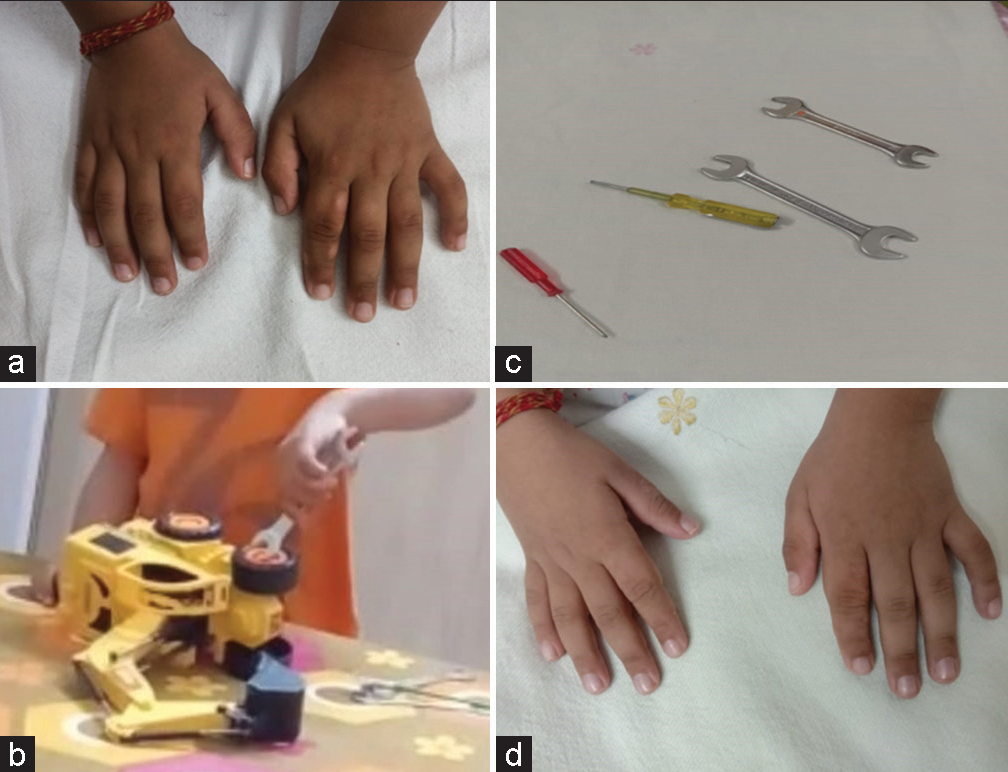Translate this page into:
Toy tools induced calluses on hands in a child during COVID-19 era

*Corresponding author: Mohita Mahajan, Department of Dermatology, Government Medical College, Amritsar, Punjab, India. mohitamahajan96@gmail.com
-
Received: ,
Accepted: ,
How to cite this article: Mahajan M, Mahajan BB. Toy tools induced calluses on hands in a child during COVID-19 era. CosmoDerma 2023;3:124.
Dear Sir,
A callus (or callosity) is a circumscribed hyperkeratosis of the skin produced by repeated or constant friction or pressure at a particular site. Its central part is thickest, gradually tapering to the periphery and merging with the normal skin. An inherited disposition to callosities has been described with an autosomal dominant inheritance.[1] These are painful and characterized by the development of painful keratotic lesions over pressure points. Callosities on hands are uncommon in children since they are produced by repeated friction and pressure.
A 4-year-old male child was brought by mother with multiple asymptomatic raised lesions over the bilateral index fingers and left middle finger for 8 months [Figure 1a]. As per the history given by mother, due to the closure of schools during COVID-19 pandemic, the child played at home with tools such as screwdriver and spanner [Figure 1b and c] for a duration of about 1 h/day for about 3 months following which he developed these lesions.

- (a) Multiple calluses on both hands, (b) child playing with tools, (c) tools used (screwdriver, spanner). (d) After 3 months follow-up, near-complete remission of callosities seen.
On examination, lesions in the form of hyperkeratotic plaques of size varying from 0.5 cm × 1 cm to 1 cm × 2 cm with well-defined regular margins were present on the outer and inner aspect of bilateral index finger, left middle finger inner aspect. It was not associated with any tenderness. No other site was affected. No family history of callosity was present. Since the child was left-handed, so more calluses developed on the left hand.
Calluses represent a compensatory protective response that forms a keratin shield between the outer layers of the skin and contact point of an article of equipment. Significant calluses also may be observed on the palmar surface of the hands of boxers, golfers, tennis players, and gymnasts.[2]
In the autosomal dominant hereditary callosities, blisters occur at the periphery of hyperkeratotic skin.[2] Callosities should be differentiated from corns and warts. A callosity lacks the penetrating central white keratinous core of a corn but is rather a diffuse thickening. Multiple bleeding points are seen on paring the superficial layers of warts but not in corns or callosities. There is a loss of dermatoglyphics at margins of warts while dermatoglyphics are accentuated in callosities.[1]
In our case, the mother was counseled and advised regarding the avoidance of playing of child with these tools and to apply emollients topically. After 3 months, near complete remission of callosities was seen [Figure 1d].
Here, we report a case of multiple calluses induced by tools during the homestay in COVID-19 pandemic. To the best of our knowledge, this is the first report of multiple calluses on hands of a child by toy tools during COVID-19 era. This case is being reported for its unusual occurrence in COVID-19 era.
Declaration of patient consent
The authors certify that they have obtained all appropriate patient consent.
Conflicts of interest
There are no conflicts of interest.
Use of artificial intelligence (AI)-assisted technology for manuscript preparation
The authors confirm that there was no use of artificial intelligence (AI)-assisted technology for assisting in the writing or editing of the manuscript and no images were manipulated using AI.
Financial support and sponsorship
Nil.
References
- Sauer’s manual of skin diseases United States: Lippincott Williams & Wilkins; 2017.
- [Google Scholar]





